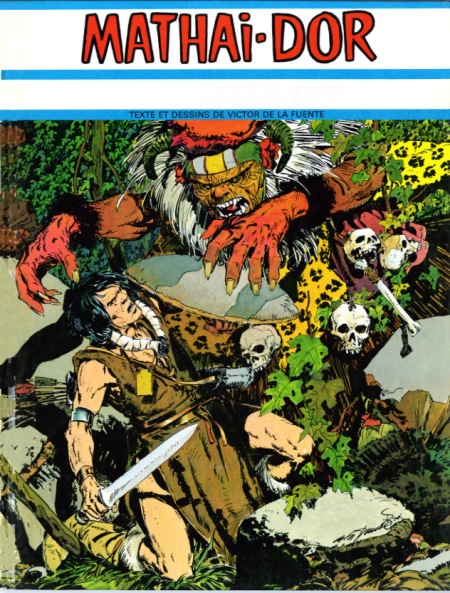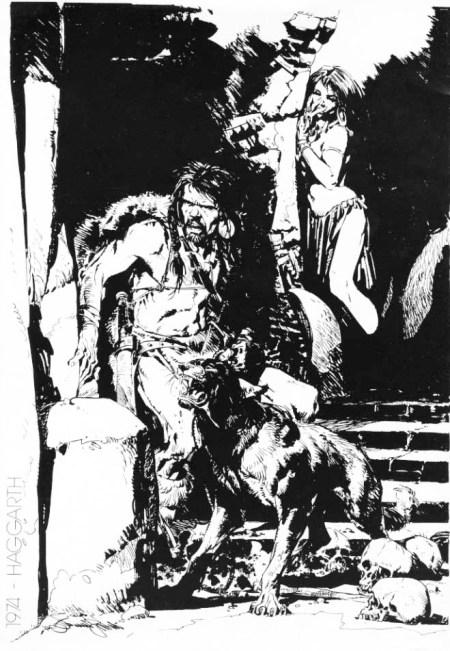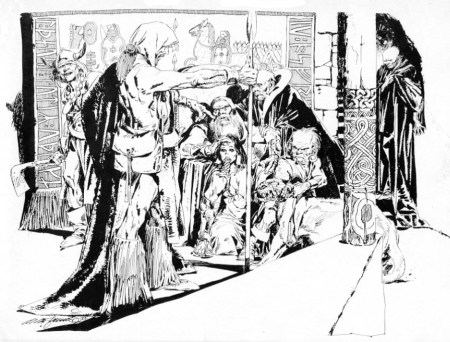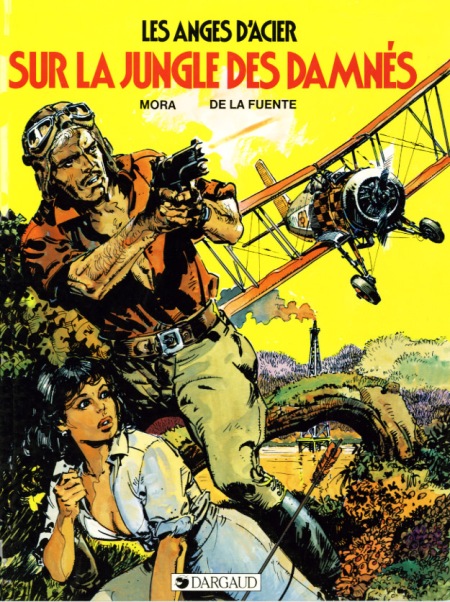Victor de la Fuente, Spain’s foremost comic book illustrator recently passed away in France where he lived for almost four decades. Victor de la Fuente was my friend for just as many years.
Born in 1927 in Asturias, Spain he was the eldest of three brothers. All three siblings shared a common interest which was to draw for the comics. In the mid forties, Victor started working at what could be best described a ‘comic book factory’. It was headed by, for a lack of a better word; a frustrated artist turned into a businessman. All the kids were huddled together, shoulder to shoulder feverishly drawing as fast as they could to satisfy the demands of the owner. It was straight from a Charles Dickens novel. At the age of eighteen Victor set sail for Chile, with the promise from a friend for a job once he arrived. However, the ship sailed only as far as Buenos Aires. he met another Asturian. He explained to his new found friend that he didn’t have any money to pay for the hotel, much less to buy any drawing materials. The Good Samaritan lent him enough money to get to Santiago, Chile where he eventually got a job. Most of the work he was assigned had nothing to do with comics. It was mostly for advertising.
Victor worked in Chile for almost fifteen years. In 1957, he returned to comics and was editor of the prestigious EL INTREPIDO PENECA doing most of the covers and illustrations. One day he received a letter from Joseph Toutain who was a cartoonist agent in Spain, SELECCIONES ILUSTRADAS, with an offer to do comic book work for FLEETWAY and DC THOMSON in London. Victor quit his job in Chile and with his beautiful new bride, Elena, he packed his things and sailed back to Spain. From Barcelona the two newly married couples (Joseph Toutain was also recently married) went to London, signed a contract with the British firm, and came back to Barcelona with an armful of scripts that dealt with the British Armed Forces during the Second World War. After ten years drawing war stories, killing a bunch of Nazis and near one hundred titles plus five hundred pages later he turns in his last page. (I should have been awarded the Victoria Cross for valor’, Victor laments). Tired and bored with the war stories Victor decided to team up with one of Spain’s foremost writers, Victor Mora, and they created a character from the American West called SUNDAY.
The character SUNDAY comes home at the end of the civil war to find his home burned to the ground and a tombstone inscribed with his wife’s name. Each story consisted of twenty four pages and each episode dealt mostly with SUNDAY helping friends and strangers from difficult situations. SUNDAY did rather well and what Victor enjoyed best of all was being able to sign his name for the first time. The adventures of SUNDAY were edited in twenty four countries and translated in more than sixteen languages before it was published in Spain. In spite of the popularity of the character, Victor was not compensated enough as the contract called for. So, Victor left the series after twelve episodes and his brother, Ramon, continued it for a while before leaving it too. By 1971 Victor decided to create a character unlike any other that he had done or anyone else for that matter. He wanted a character with the same values that he was brought up with. The hero was called HAXTUR (which can be inferred for Victor’s place of birth, Asturias and King Arthur). Victor approached a Spanish comic book publication TRINCA by the EDITORIAL DONCEL which was run by the Jesuits and a government agency which still was under the dictatorship of Generalissimo Franco. The publication of HAXTUR catapulted Victor de la Fuente to a world wide audience. Each complete episode consisted of six pages It soon became evident these stories were not drawn or written for children It dealt mostly with the iniquity of the human race. It was about injustice, suppression, and the quest for power to dominate (a recipe for trouble with the Fascist government in Spain). A newspaper article claimed that Victor de la Fuente’s HAXTUR was apparently political. This brought a threat by the minister of information. With the risk of a fine and maybe imprisonment, Victor resorted to semantics with his story line. When the HAXTUR series finally ended with the twelfth episodes, the editor asked for another series but he wanted to make sure that it would not have any political overtones. In that same year WARREN PUBLICATIONS published “I Am Dead Egypt, Dead’, story by Doug Moench and drawn by Victor.
Victor created MATHAI-DOR in 1972. But by then Victor was having problems securing the rights for his HAXTUR character and now with MATHAI-DOR plus the constant annoyance of being censored by the authorities, Victor quit TRINCA, packed all his belongings and with his wife and two daughters moved to Paris were he could work unimpeded. Then he did a series of work from Italy that he referred to as ‘for bread and water’. Two years later after he left TRINCA the two volumes of MATHAI-DOR were published in France by HACHETTE. By 1975 Victor embarked on his own creation with another character from the west called AMARGO. HACHETTE published two AMARGO albums, (44 pages per) but because of problems with rights for the artist and author he dropped the series after the second volume. In 1976, along with other well known illustrators from Europe, Victor was asked to do a series of books on the history of France by the LAROUSSE PUBLICATIONS.
#9-10-11-12-13-14
In 1978 Victor embarked on one of his most ambitious graphic novel, HAGGARTH. It was to be a tetralogy but unfortunately the fourth volume was never finished. HAGGARTH was serialized in A SUIVRE a monthly magazine published by CASTERMAN. In 1980, Victor did a series of albums for DARGAUD. In 1982 HAGGARTH was serialized by the WARREN PUBLICATIONS in Eerie. 1983 Victor, along with other European artists, was commissioned to do a series of albums on Bible stories by LAROUSSE. Teaming up again with Victor Mora 1989 they did four albums titled ANGELS of STEEL for DARGAUD. By 1992 Victor teamed up with another well known writer, Jean-Michel Charlier, for six albums called LOS GRINGOS, A story of two soldiers of fortune during the Mexican Revolution, for FLEURUS and ALPEN PUBLISHERS.
Later in the 90’s, he did some religious biographies and a few albums with Jodorowsky, Mora, Cothias (JOSUE DE NAZARETH, a controversial version of the Christ life), for EDITIONS DU SIGNE, ALPEN, ALBIN-MICHEL, BAYARD, GLENAT. BONELLI, the most famous Italian publisher contacted the ‘crème de la crème’ in the international cartoonist market to do a special collection of Tex Willer albums (Joe Kubert, Jordi Bernet, Alfonso Font, Jose Ortiz, Manfred Sommer and many others Italian and European masters). Victor illustrated FIAME SULL’ARIZONA an album of 220 pages and 3 other stories about the same length.
Victor died a few days after Al Williamson, a close friend, for who he did some ghosting on the STAR WARS strip.
To try and enumerate all or simply most of Victor de la Fuente’s work would be practically impossible. The man was a genius. He was a prolific artist unsurpassed by many of his peers. Admired and respected by his legions of fans and colleagues around the world. To say that his passing will be sorely missed would be an understatement. He was a Gentleman of the old school (a rare breed nowadays). I believe one of the most apropos tributes bestowed upon him was by his old and dear friend and fellow artist, Carlos Gimenez. He once told me that should he come back after he is gone, he would like to come back as Victor de la Fuente.
I feel very fortunate to have known him for many years. To me, having him as a friend was not simply a pleasure but an honor. He was a loving and a giving person. A kind person to a fault. I found him to be a modest and a humble person. I remember a time I was at his house and asked to see the Yellow Kid award he recently received (it’s the most prestigious award an artist can receive in Europe). He took me to his room and opened the door to his closet and there were a myriad of awards he had received through the years of his career. While other artists like to display their trophies on the mantel or in a glass cabinet, Victor had his inside his closet. His unassuming nature was so typical of Victor de la Fuente, the likes that we shall never see again.
Adios Victor!
Manuel
















August 7, 2010 at 3:31 am |
I was a big fan of Señor de la Fuente even without knowing I was a fan of his. I was introduced to his work through the War and Battle comic digests while growing up. His work stood out even among the other great artists who were contributing to these little books. Of course his name was not credited in those books so I never knew who the artist was. I thought all along that he was British. That was until I found out from Jordi Bernet at Super Con in Oakland in 2006 that the artist that I have been following all these years was none other than Victor de la Fuente. Ever since then I have looked far and wide for his other works, which were more than I had imagined. I found out about his passing only today. It truly is a big loss for
the medium. I will still be searching for more of his works. RIP, Señor de la Fuente. You will be missed by this fan who will always cherish your works.
August 10, 2010 at 6:23 am |
Dear Mr. Auad,
My sympathies to you on the loss of your friend. I have to admit that I’m not familiar with the work of Mr. De La Fuente, but the samples in your post are magnificent.
August 10, 2010 at 10:09 pm |
Thanks for sharing. I’d never heard of Victor de la Fuente and this story highlights how many hundreds of thousands of unrecognised geniuses there are out there.
August 21, 2010 at 3:16 pm |
This is such incredibly sad news. He was an absolute genius (not a word I use often) and master of his craft. I have followed his work for decades and try to pick up as much as possible of it whenever I’m abroad. What a loss to our industry and to art as a whole.
August 21, 2010 at 3:19 pm |
I’m going to pass this around as those who don’t know his work should really be made aware.
August 21, 2010 at 7:18 pm |
Thanks, Joe. I know he would appreciate that very much.
Manuel
August 21, 2010 at 7:31 pm |
My pleasure! Will you be planning any comprehensive collections of his work? He certainly deserves a huge tome covering the breadth of his career.
August 22, 2010 at 1:55 am |
He is one of the best!
November 8, 2010 at 6:22 pm |
I’ve never heard of this artist before, but I definitely will check out some more of his work. It’s too bad I found out about him only after he died.
December 15, 2010 at 3:27 pm |
Fabuleux dessinateur , il reste un modele pour moi comme pour beaucoup d’illustrateur (bien que son style trés particulier fait de force et de virtuosité dissuade l’imitation).
October 18, 2012 at 7:23 am |
That is really interesting, You are a very professional blogger.
I’ve joined your rss feed and look forward to searching for more of your great post. Additionally, I’ve shared your web site in my social
networks
May 9, 2013 at 9:10 pm |
number one,artist